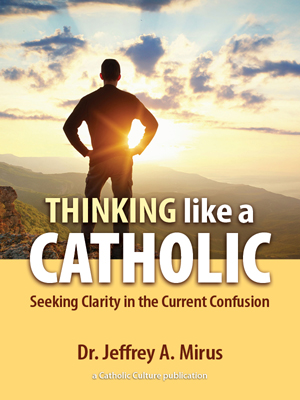Feastday Highlights: Solemnity of Corpus Christi
By Jennifer Gregory Miller ( bio - articles - email ) | Jun 20, 2014 | In The Liturgical Year
The Thursday (or Sunday in the United States) following the feast of the Holy Trinity is the Solemnity of the Most Holy Body and Blood of Christ (Latin title Corporis et Sanguinis Christi). This feast is traditionally referred to as Corpus Christi, as there were originally two separate feast days, one for the Body of Christ, the other for the Blood of Christ, but this is now a combined feast day
Free eBook:

|
| Free eBook: Thinking like a Catholic |
This is a feast of devotion that originated in 13th century to give special honor to Jesus in the Eucharist. It is one of the holydays of obligation listed in the Code of Canon Law, but the obligation is lifted in the United States.
Devotions for this day are often expressed through Eucharist processions, such as Father Weiser or Maria Von Trapp describes. There are traditions of creating flower carpets, such as in Spain, or as in Pittsburgh, Sawdust carpets. These decorations cover the paths where the procession will proceed.
Reading the section under Corpus Christi in The Directory on Popular Piety and the Liturgy is particularly applicable for this feast. The document provides guidelines on Eucharistic devotion, continuing with instructions for Corpus Christi processions and Eucharistic adoration. There is an emphasis on the continual connection and emphasis on the Eucharistic sacrifice:
161. Eucharistic devotion, which is so deeply rooted in the Christian faithful, must integrate two basic principles:
- the supreme reference point for Eucharistic devotion is the Lord's Passover; the Pasch as understood by the Fathers, is the feast of Easter, while the Eucharist is before all else the celebration of Paschal Mystery or of the Passion, Death and Resurrection of Christ;
- all forms of Eucharist devotion must have an intrinsic reference to the Eucharistic Sacrifice, or dispose the faithful for its celebration, or prolong the worship which is essential to that Sacrifice.
Hence, the Rituale Romanum states "The faithful, when worshipping Christ present in the Sacrament of the Altar, should recall that this presence comes from the Sacrifice of the Eucharist, and tends towards sacramental and spiritual communion"169.
The section continues with understanding other forms of Eucharistic adoration and keeping the continual focus on the liturgy. Of particular interest is the guideline for personal prayer during adoration in front of the Blessed Sacrament, with the pointing of use of liturgical prayers, such as the Divine Office:
The faithful should be encouraged to read the Scriptures during these periods of adoration, since they afford an unrivaled source of prayer. Suitable hymns and canticles based on those of the Liturgy of the Hours and the liturgical seasons could also be encouraged, as well as periods of silent prayer and reflection. Gradually, the faithful should be encouraged not to do other devotional exercises during exposition of the Blessed Sacrament. Given the close relationship between Christ and Our Lady, the rosary can always be of assistance in giving prayer a Christological orientation, since it contains meditation of the Incarnation and the Redemption.
We can use this feast to recall our First Holy Communion dates within the family. Many processions on this day invites the children who have received their First Holy Communion to wear their white finery and lead the procession.
Feast day foods can help recall the "fruit of the earth" and "fruit of the vine" gifts that are transformed into Christ's Body and Blood: bread and wine (or grapes or grape juice).
The Feast of Corpus Christi highlights the most precious gift we have of Jesus in the Holy Eucharist, Who is "the source and summit of the Christian life" (Catechism of the Catholic Church, #132). May your family to continue to grow in the life of Christ the True Vine.
All comments are moderated. To lighten our editing burden, only current donors are allowed to Sound Off. If you are a current donor, log in to see the comment form; otherwise please support our work, and Sound Off!








